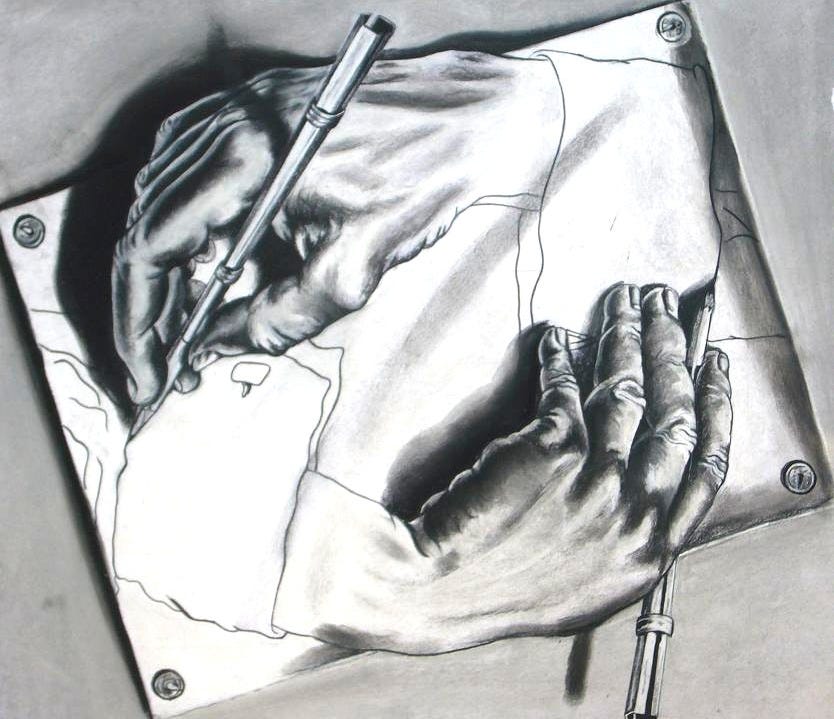Reflexivity and the Dynamics of Social Distortion
We need to re-complicate notions of the self so as to "be real" about what shapes us and who we really are. All actions are reactions.
The so-called “Rule of 7” holds that it takes seven “impressions” before you make an impression or trigger some kind of action. Thus marketers flood the zone with billboards, ads, podcasts, commercials, and apps with ad campaigns in order to make as many impressions as possible. Some of these are “smart bombs” or targeted ads, while some are, well, “dumb”—scattershot and indiscriminate.
I am not in sales, but I do my best to notice things. I spend most of my days training students in the fine art of observation, and in my classroom the targets are both patterns and details regnant in old books. My toxic trait is that I believe I can teach anyone to start noticing better, even the guy in the back who says “I’m just not really an English type of student.” Nonsense. We human beings are noticers.
I do not know where I first heard the term “reflexivity” but I remember the first time it left an impression such that I became conscious. I had read
’ excellent book Wanting once before, but in preparing it for my “defense against the dark arts” class this year, it suddenly clicked. Having watched classroom and dining hall and athletic field dynamics for nearly 20 years, this concept began to resonate with my long-term memories.Incidentally, when you read a book alone, for your own edification, you see certain things. When you read a book with a group of teenagers you know pretty well, the seeing-yield is quite different. You suddenly start to see things differently, where alternative words and concepts make themselves available to your attention. An example of this was with C. S. Lewis’ That Hideous Strength, a book I had read twice and listened to once before class this year. In re-reading it to teach it, suddenly whole aspects of the novel became manifest. Reading an already mapped book in the context of my students altered the terrain, requiring an update. The book contained so much more than I had originally seen. Now my map of that classic is much more sophisticated. So, a positive example of reflexivity. My students live “rent-free” in my head, forever changing what I see.
The concept of reflexivity—a circular, self-referential relationship between cause and effect where actions, observations, or beliefs influence the very systems or individuals they describe, and vice versa—offer us an insight into influencing and being influenced. In the above example, my students where influenced by me and what I bring to the table, and they in turn influenced me. Reflexivity seems to be a powerful aspect of the dynamic of sociality, and this dynamic is potentially positive and negative. The question can be asked: reflexive to what and reflexive by what?
Burgis attributes it to George Soros (don’t worry…I’m not using Soros as a dog whistle…I promise):
The billionaire investor and activist George Soros has claimed that financial markets operate according to the principle of reflexivity. “In situations that have thinking participants, there is a two-way interaction between the participant’s thinking and the situation in which they operate,” he writes in his book The Alchemy of Finance. Reflexivity in markets is partly what leads to market crashes and bubbles. Investors perceive there might be a crash, so they behave in a way that precipitates the crash. (58)
In some strange (alchemical?) way, we effect things by thinking about them, and the unspoken but felt “forces” act upon us, too. How do we signal and influence one another without exchanging words? Reflexivity operates outside the bounds of a material sense of causation. Anyone who has taught for more than a few weeks knows of the ins and outs and weirdnesses of group dynamics. One year, about a month into school, a once warm and open class became wildly erratic and uncomfortable when a new student was late-enrolled. She was beautiful and even charming. The boys were immediately in love and began their various rituals. The girls were immediately jealous, in no small part to the boys’ (over) reaction and the new girls unarguable charm. Let’s just say that there were only a couple of (somnambulant) souls unaffected by her insertion into the dynamic. She demanded a reaction. The section was irrevocably altered. It was neither good nor bad, but her simple addition changed the inputs and changed the weights. The deep stirrings of mimetic desire were super-activated.
The dynamics of mimetic distortion were reverberative. The distortion was real. Some once-chatty girls clammed up. Some once-sleepy boys suddently looked for opportunities to flex, due in no small part to the new girl’s genuine interest in the material, and her active participation. In reflexivity, awareness and action are intertwined: we affect others and other affect us. Social distortion.
Keep reading with a 7-day free trial
Subscribe to The Underneath to keep reading this post and get 7 days of free access to the full post archives.




